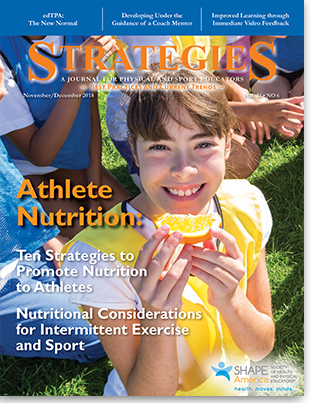 Strategies Table of Contents
Strategies Table of Contents
Ten Practical Strategies Coaches Can Use to Promote Nutrition to Their Athletes
Shelley L. Holden and Timothy M. Baghurst

There are more than 460,000 student-athletes participating in a myriad of sports in the National College Athletic Association (2018), and approximately 60,000 boys and girls are registered in organized youth sports (National Council of Youth Sports, 2017) in the United States. Although coaches are expected to understand the practical Xs and Os and physical training necessary to be successful in a given sport, they must also recognize that there is more to an athlete’s performance than just sport-specific training and the weight room. That is, many coaches are educated about the techniques and strategies for their sport, but they may lack knowledge in other sport performance areas, such as nutrition. Th is article provides 10 practical strategies that can be used to educate both current and future coaches on what it takes to fuel athletes nutritionally for optimal performance. Furthermore, it provides several ways to incorporate nutritional information into team and parent meetings, training and competition, and travel itineraries, as well as ways to teach daily nutritional choices. Because sports nutrition is constantly changing, it is imperative that coaches stay up to date with the newest information in this evolving field.
1. Coaches Should Educate Themselves about Nutrition
Coaches must possess a basic understanding of how nutrition affects health and athletic performance. Unfortunately, a plethora of books and websites devoted to nutrition fail to provide accurate and/or appropriate information for the age level and sport or activity being coached. When seeking educational resources, coaches should check the author’s credentials. That is, are they a registered dietitian (RD), a licensed physician (MD), an academic scholar (PhD or EdD), a certified strength and conditioning coach (CSCS), or a certified athletic trainer (ATC)? Th at is not to say that books or websites authored by individuals without credentials are necessarily incorrect or not of value, but rather, checking credentials is a place to start when seeking to obtain sound nutritional information.
Another important consideration when seeking educational resources is to read nutrition information provided by agencies/ organizations in the field. Examples include the Dietary Guidelines for Americans (Dietary Guidelines Advisory Committee, U.S. Department of Agriculture, U.S. Department of Health and Human Services, 2015) or the American College of Sports Medicine (ACSM) position statements on “Nutrition and Athletic Performance” (ACSM, 2016), “Exercise and Fluid Replacement” (ACSM, 2007a), and “The Female Athlete Triad” (ACSM, 2007b). By focusing on reading materials written by credible sources in the field, coaches can avoid obtaining and teaching information that may be inaccurate and/or potentially dangerous for their athletes. Simply passing on information to athletes from an unreliable source could place a coach in an unfortunate situation or even lead to a lawsuit, depending on the situation’s severity.
To read the rest of this article, click here to download a pdf.